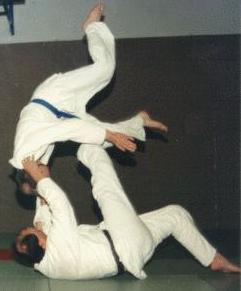Throw (grappling)
A technique in grappling martial arts
Throw in grappling refers to a technique used to off-balance or lift an opponent and bring them to the ground. Throws are a fundamental aspect of many martial arts, including judo, wrestling, sambo, and Brazilian jiu-jitsu. They are used to gain a dominant position, score points, or incapacitate an opponent.
Types of Throws[edit]
Throws can be categorized based on the part of the body used to execute the technique or the direction in which the opponent is thrown.
Hip Throws[edit]

Hip throws, or koshi-waza in judo, involve using the hip as a fulcrum to lift and throw the opponent. A common example is the O-goshi, where the thrower turns their back to the opponent, grips them around the waist, and uses the hip to lift and project them over the shoulder.
Leg Throws[edit]
Leg throws, or ashi-waza, utilize the legs to sweep or reap the opponent's legs, causing them to fall. Techniques such as Osoto-gari and Uchi-mata are classic examples where the thrower uses their leg to disrupt the opponent's balance and execute the throw.
Sacrifice Throws[edit]
Sacrifice throws, or sutemi-waza, involve the thrower intentionally falling to the ground to execute the technique. The Tomoe-nage is a well-known sacrifice throw where the thrower falls backward while placing a foot on the opponent's stomach to flip them over.
Historical Depictions[edit]

Throws have been depicted in various historical contexts, illustrating their long-standing presence in martial arts. Medieval manuscripts often show knights and soldiers using throws in combat.

The Angkor Wat bas-reliefs in Cambodia also depict scenes of combat, including grappling techniques that resemble modern throws.

These historical artworks highlight the universality and timelessness of throwing techniques in martial arts.
Cultural Significance[edit]
Throws are not only practical techniques but also hold cultural significance in many martial arts traditions. In judo, for example, the execution of a perfect throw is seen as an art form, embodying the principles of balance, timing, and efficiency.
Training and Application[edit]
Training in throws requires understanding the principles of balance, leverage, and timing. Practitioners often drill throws repeatedly to develop muscle memory and precision. In competition, throws can be used to score points or achieve a tactical advantage.
Related Pages[edit]
Ad. Transform your life with W8MD's Budget GLP-1 injections from $75


W8MD offers a medical weight loss program to lose weight in Philadelphia. Our physician-supervised medical weight loss provides:
- Weight loss injections in NYC (generic and brand names):
- Zepbound / Mounjaro, Wegovy / Ozempic, Saxenda
- Most insurances accepted or discounted self-pay rates. We will obtain insurance prior authorizations if needed.
- Generic GLP1 weight loss injections from $75 for the starting dose.
- Also offer prescription weight loss medications including Phentermine, Qsymia, Diethylpropion, Contrave etc.
NYC weight loss doctor appointmentsNYC weight loss doctor appointments
Start your NYC weight loss journey today at our NYC medical weight loss and Philadelphia medical weight loss clinics.
- Call 718-946-5500 to lose weight in NYC or for medical weight loss in Philadelphia 215-676-2334.
- Tags:NYC medical weight loss, Philadelphia lose weight Zepbound NYC, Budget GLP1 weight loss injections, Wegovy Philadelphia, Wegovy NYC, Philadelphia medical weight loss, Brookly weight loss and Wegovy NYC
|
WikiMD's Wellness Encyclopedia |
| Let Food Be Thy Medicine Medicine Thy Food - Hippocrates |
Medical Disclaimer: WikiMD is not a substitute for professional medical advice. The information on WikiMD is provided as an information resource only, may be incorrect, outdated or misleading, and is not to be used or relied on for any diagnostic or treatment purposes. Please consult your health care provider before making any healthcare decisions or for guidance about a specific medical condition. WikiMD expressly disclaims responsibility, and shall have no liability, for any damages, loss, injury, or liability whatsoever suffered as a result of your reliance on the information contained in this site. By visiting this site you agree to the foregoing terms and conditions, which may from time to time be changed or supplemented by WikiMD. If you do not agree to the foregoing terms and conditions, you should not enter or use this site. See full disclaimer.
Credits:Most images are courtesy of Wikimedia commons, and templates, categories Wikipedia, licensed under CC BY SA or similar.
Translate this page: - East Asian
中文,
日本,
한국어,
South Asian
हिन्दी,
தமிழ்,
తెలుగు,
Urdu,
ಕನ್ನಡ,
Southeast Asian
Indonesian,
Vietnamese,
Thai,
မြန်မာဘာသာ,
বাংলা
European
español,
Deutsch,
français,
Greek,
português do Brasil,
polski,
română,
русский,
Nederlands,
norsk,
svenska,
suomi,
Italian
Middle Eastern & African
عربى,
Turkish,
Persian,
Hebrew,
Afrikaans,
isiZulu,
Kiswahili,
Other
Bulgarian,
Hungarian,
Czech,
Swedish,
മലയാളം,
मराठी,
ਪੰਜਾਬੀ,
ગુજરાતી,
Portuguese,
Ukrainian